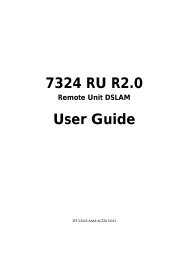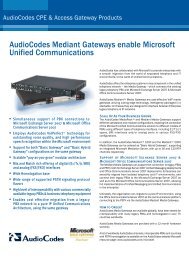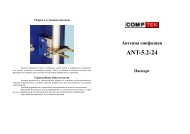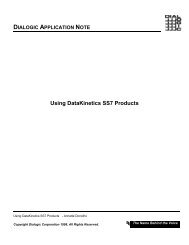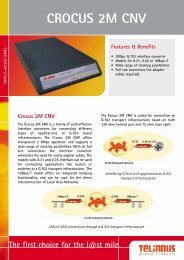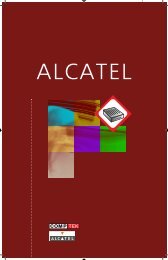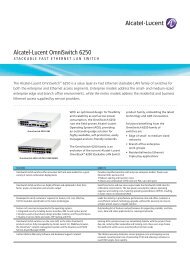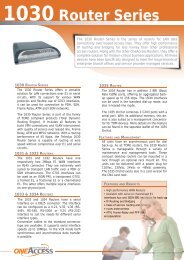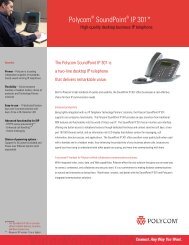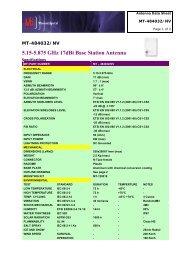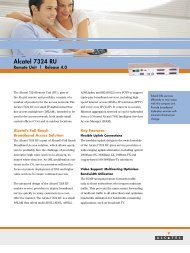Intel® Signaling System 7 Solutions - CompTek
Intel® Signaling System 7 Solutions - CompTek
Intel® Signaling System 7 Solutions - CompTek
Create successful ePaper yourself
Turn your PDF publications into a flip-book with our unique Google optimized e-Paper software.
a channel with two other streams of user data, each in its owntime slot. GSM operates at either the 900 MHz or 1800 MHzfrequency band.Home Location Register (HLR)An ultra-high-speed database containing the current home servingcell for a mobile handset.Integrated Access Device (IAD)Customer premises equipment used to aggregate diverse traffictypes such as voice and data.Integrated Services Digital Network User Part (ISUP)Provides standards-based and network-specific call controlservices for wireless and wireline PSTN networks.Intelligent Network (IN)A telephone network architecture that separates service logic fromswitching equipment, allowing new services to be added withoutredesigning switches to support those new services.Intelligent Network Application Part/Protocol (INAP)Efficiently enables network services and customer applicationswithin the distributed environment of the Intelligent Network.Networks using INAP deliver easily programmable services on aper customer basis, such as follow-me, televoting, pre-paid, andcredit card calls.Intelligent PeripheralsA network system in the Advanced Intelligent Network (AIN)Release 1 architecture containing a resource with a ResourceControl Execution Environment (RCEE) functional group thatenables flexible information exchange between a user and thenetwork.Interim Standard 41 (IS-41)Renamed ANSI-41 on becoming a standard.Internet Message Access Protocol (IMAP)A standard protocol for accessing e-mail from a local server.Local Number PortabilityAllows telephone subscribers to keep the same telephone numberas they change their operating environment (home, car, street,workplace, etc.).Message Transfer Part (MTP)Provides physical, data link, and network layer functions. MTPtransports information from the upper layers (including the userparts and SS7 applications) across the SS7 network. Refers tolevel 1 through 3 in the SS7 protocol stack (MTP1-MTP3).Mobile Application Part (MAP)SS7 standards that address the registration of roamers and theintersystem hand-off procedure in wireless mobile telephony.Mobile Switching Center (MSC)A switch providing services and coordination between mobileusers in a network and external networks.Mu-Law (µ-Law)A Pulse Code Modulation (PCM) coding and compandingstandard used in North America and Japan. (-Law is theencoding method used in the 1.544 Mbps, 24-channel PCMsystem known as T-1.Network User Part (NUP)A variation of ISUP used in the United Kingdom.Out-Of-Band <strong>Signaling</strong>Telecommunications signaling on a channel dedicated for thatpurpose and separate from the channels used for the telephonecall itself. Out-of-band signaling is used in <strong>Signaling</strong> <strong>System</strong> 7,the latest standard for the signaling that controls the world'stelephone calls.Overlap <strong>Signaling</strong>The process of setting up a call by sending dialed digits one at atime, as they are dialed by the originating device.QSIGQSIG is an ISDN based protocol for signaling between nodes of aPrivate Integrated Services Network (PISN). QSIG can be used inall of the following applications:• Multi-vendor PBX networking• Attachment of ancillary equipment (e.g., voice mail systems,paging equipment, wireless base stations) to a PBX network• Virtual Private Networks (VPN)• Broadband private networks• Linking Trans-European Trunked Radio (TETRA) areas• VoIP (H.323) applicationsRemote Operations Service Element (ROSE)An application layer protocol that allows remote operations at aremote process.19



